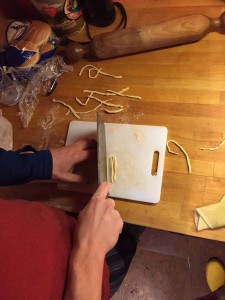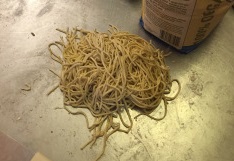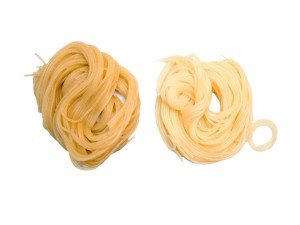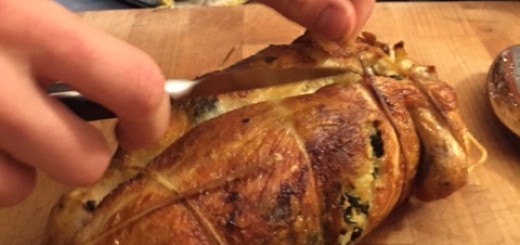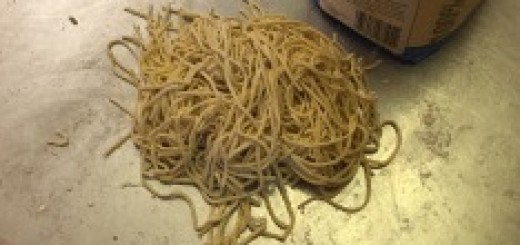Our Ramen and Alkalinity: A Scientific Explanation
When we made ramen soup for the class we found a recipe from the “curious cook” often called a food chemist, Harlod McGee. McGee’s recipe instructed us to bake baking-soda for an hour apparently transforming it, through the loss of some water and CO2 molecules, into a new molecule called sodium carbonate. Apparently this sodium carbonate is a a more alkaline version of baking soda (which is already one of the more alkaline cooking ingredients we interact with regularly), and this alkaline white powder has a transformative effect on a basic flour and water noodle dough. We wanted to know more so we spent some time researching and came up with the following results.
A good place to start is the origin of why Alkaline noodles were created, here is an excerpt from Harold McGee’s article, “On Alkalinity”, published in Lucky Peach magazine, that gives way to how these noodles came to be.
“I’ve been curious as to how it was that alkaline noodles first came into existence. I’ve tried to find out and it’s just not clear. It seems that the first written records of alkaline noodles come from southern China. The speculation is that because the weather is much more hot and humid down there than it is in other noodle-making parts of China, the addition of alkaline ingredients might have begun as a way of helping the noodles stay fresher longer. If you make a dough in warm conditions, it’ll eventually turn into a sourdough. One way to compensate for that is to add unacid, an alkaline ingredient, to counteract whatever acidity might develop. But that’s a guess; we don’t really know for sure. We just know that noodles with alkaline ingredients tend to come from southern China, and have lived on past the point of our needing to protect against the acidification of the dough.” McGee
Alkaline noodles work so well in Asian soups because they have certain qualities that make them especially useful in hot liquids. First, adding an alkaline substance increases the strength of the noodles so that they will hold up in the hot ramen broth.
The traditional Chinese alkaline component used in noodles was a mineral rich substance called Kansui, which is a combination of sodium carbonate and potassium carbonate. As we learned from McGee it is possible to make an alternative for this by baking a common household ingredient: baking soda.
(photo by Bonnie Zion)
Baking soda has a pH somewhere between 8-9 when dissolved in water. To transform this substance into a stronger alkali all you have to do is bake it. After an hour of baking at 250 degrees F, the water and carbon dioxide are released and what you are left with is sodium carbonate, which will act far differently than baking soda in its original form.
We found this chart from Michael Laiskonis at Lucky Peach showing different alkalis and their pH. If you compare rows one and two, the chart shows the change in pH between normal baking soda and baked baking soda or “soda ash”, a notable 3.2 increase in pH.
Alkaline Base AKA Formula pH sodium bicarbonate baking soda
NaHCO3 8.4 sodium carbonate soda ash NaCO3 11.6 potassium carbonate potash K2CO3 11.5 kasui Chinese lye water 10.0-12.0 sodium hydroxide lye, caustic soda NaOH 12.0-14.0 (Opusculum: Alkaline Ramen Noodles, Laiskonis)
Texture Change
Where the alkalinity becomes especially important is it’s influence on the texture of the noodle. If you just put a regular noodle in a hot broth for any extended amount of time the proteins would fall apart and the noodle will dissolve in your bowl. Alkalinity strengthens the noodle and slows this process down significantly. While we couldn’t find any good explanations of the mechanism by which alkalinity effects wheat proteins, we did learn more generally about how pH can drastically change protein structure and food texture. The Nordic Food Lab tackles this phenomenon in their research post, Cooking with Alkali, in which they discuss alkalis and their affects on proteins, here are some of their explanations on textural change:
Proteins consist of long chains of amino acids, or polypeptides, folded into a specific three-dimensional shape. This shape is determined largely by the amino acids’ interactions with each other, the aqueous solution surrounding them, and by the action of enzymes that modify the folding process following synthesis. A protein tends to fold into a conformation that minimizes the energy of the system – that is, the protein and its environment. For example, positive charges move as far away from each other as possible, and the bonds between positively and negatively charged chemical groups are maximized.
Lowering the pH of a food by, say, marinating it in vinegar, involves surrounding its proteins with hydronium ions, which can donate positively charged protons to parts of amino acids along the chain, among other effects. Chemical groups in the protein and the surrounding solution rearrange themselves accordingly, and the protein changes shape – it becomes denatured. This process can alter the texture and appearance of foods, as occurs in seafood ‘cooked’ in acid in a ceviche.
(Cooking with Alkali, Nordic Food Lab)
In the above qoute the Nordic Food Lab (NFL) describes proteins as an intricately folded structure, maintained in their shape by balanced charges on different parts of the structure. The structures are composed of different amino acids (the basic building blocks of all protein). You can picture a protein in a raw fish, for example, as a complex modernist artist sculpture with many moving parts all tangled up with itself but somehow stable. The change in pH brought with a vinegar marinade can change the charges on parts of this protein; the stability of the sculpture is ruined and it unfolds its many parts. Once unfolded these parts may sprawl out and begin interacting with pieces of neighboring proteins and form new structures. Another post by the NFL describes this chemical process in ceviche:
“In ceviches, everything is about pH. Proteins change because of acid – the introduction of new hydrogen atoms disrupts the hydrogen bonding within and between amino acid chains. Acids thus denature the proteins’ quaternary and tertiary structures (the specific shapes that emerge as a result of hydrogen and other bonds), leaving them in loose strands and allowing them to reconfigure in new ways. This is the mechanism that transforms the texture of protein-rich food.”
(Cebiche/ Ceviche/ Sebiche/ Seviche, Nordic Food Lab)
It turns out alkaline salts can effect proteins as dramatically as low pH materials like acidic vinegar. Again the Nordic Food lab explained this well, writing,
“Proteins can just as easily be denatured by adjusting the pH in the opposite direction – by marinating food in an alkaline solution instead of an acidic one. Whereas acids donate protons to various chemical groups within proteins, alkalis tend to pull them away, which can have a different but comparable effect on protein structure.”
(Cooking with Alkali, Nordic Food Lab)
So alkali environments can have a comparable affect on texture because, like acidic environments, it denatures and rearranges protein structures which changes the texture of a food. Alkalinity strengthens the noodle and slows the deconstruction of the noodle in hot liquid.
Returning to ramen noodles we found Harold McGee is still the best source on how alkalinity could effect wheat noodles. In more generall terms than the NFL McGee discusses how turning the dough alkaline represents a change in the chemical environment can effect multiple kinds of molecules, from wheat proteins to pigments. In his article, On Alkalinity, McGee discusses the effects of alkalinity on ramen dough, writing,.
“By changing the chemical environment of the dough, the components in the flour change their behavior, and they change in various desirable ways. The color changes, because pigments in the flour that are ordinarily invisible become visible under alkaline conditions and take on a yellow hue. The interaction of the gluten proteins (which create the solid structure of the noodle) are also changed in such a way that the noodles become firmer. This is not that well understood, but apparently the bonding between gluten molecules becomes stronger under alkaline conditions.”
(On Alkalinity, McGee)
We experienced this gluten bonding personally when we tried to roll out our first batch by hand. It was extremely hard to work with our ramen dough. We kept rolling it out, the dough would spring back and try to return to its original resting shape. The noodles cut from this batch were too thick and chewy to be acceptable ramen noodles, but the strength of the noodles was apparent, lasting longer than the heat of our hot broth.
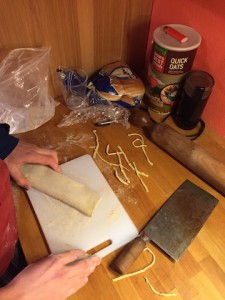
Test Batch #1, extremely hard to work with: hello gluten bonding!
So, by baking the baking soda it seems we transformed it into a proton-free solid sodium carbonate ready to pull protons away from different groups of chemicals and ultimately transform our dough into something tougher than before. Though exactly how it changed the gluten forming wheat proteins remains elusive, the result is a chewier stronger noodle.
More Effects of Alkalinity on Flavor
A water that is neutral (pH 7.0), it has an even number of protons and hydroxyls. When there are more protons, the water becomes acidic and when there are more hydroxyls the water becomes alkaline. These hydroxyls have a lot to contribute to the texture of our foods, as McGee explains here in his New York Times article “For Old Fashioned Flavor, Bake the Baking Soda”:
Hydroxyls are what break down oils and fats to make things like soap. This explains the feel of these noodles which is more slippery than others- reacting with trace amounts of oils on your skin or in your food. A stronger alkaline substance like lye for example, is simply made from hydroxyls and sodium making it substantially more corrosive than baking soda which is a carbonate substance. Baking soda does not contain these hydroxyls and instead are able to absorb protons and release hydroxyls from water making it a sodium bicarbonate. This means that it can only form with one other proton, however this changes when you bake the the baking soda- after releasing its water vapor and carbon dioxide gas it will become a solid sodium carbonate which is proton free.
(McGee, For Old-Fashioned Flavor, Bake the Baking Soda)
Another interesting effect of increased pH, though not demonstrated in our ramen noodles, is that a more alkali environment can also speed up the browning, Maillard reactions present in food. We did several experiments to test this which will be mentioned in greater detail in our natural history post about the Maillard reaction. In one experiment we soaked beef in two different marinades, one containing baking soda, salt and sugar one with only salt and sugar. The baking soda marinade ended up giving us meat that browned more and was more tender than the meat from the other marinade, seeming to brown the outside without drying the meat while it was roasted. The tenderness we hypothesized must have been a result of protein denaturing during the alkaline marinading period.
Color Change
Alkalinity will effect the color of the noodles, giving a darker yellow hue that stands out nicely in broth. The Nordic Food Lab did an experiment to show the color change in alkaline environments and why pH can change the color of our food. Here is part of their discussion:
pH can affect the colour of food much more than just the range of Maillard browns. The colour of many anthocyanins – compounds that give foods like red cabbage and blueberries their brilliant colours – changes with pH, such that red cabbage juice can be used as a pH indicator. A drop of anthocyanin-rich cabbage juice will appear red in a low pH solution, blue in a higher pH one, and eventually green and yellow in even more alkaline solutions. Another example of naturally occurring, pH-sensitive pigments can be found in litmus, a dye extracted from lichen that follows a similar progression from red at low pH to blue at high pH. More recently, this summer we observed that onions soaked in an alkali solution turn bright yellow and developed a distinctive aroma, very much like corn chips. Originally we thought this might be due to polymerisation of sulphurous compounds in alliums facilitated by the physical and chemical breakdown of the allium tissues due to exposure to the alkaline solution, though subsequent trials point towards other compounds – perhaps quercitin, an antioxidant flavonol responsible for over 85% of onion’s flavour and with yellow pigmentation which becomes enhanced when it polymerises.
(Nordic Food Lab: Cooking with Alkali)
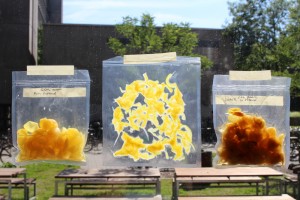
L to R: shallots, white onions, and shallots treated with Ca(OH)2; shallots in the righthand sample were cooked after alkaline soak. (NFL, Cooking with Alkali, 2014)
Again, we don’t fully understand the chemistry behind these observations except to say that the pulling away of protons by our alkali must be changing both coloring and flavor molecules in foods from onions to wheat to meat.
Flavor Change
The flavor of alkalinity is unusual. Through our own experimenting with alkalinity in food this quarter we’ve become familiar with the eggy, soapy, slightly bitter taste alkalinity can impart. It may sound unpleasant but it isn’t always. In Ramen noodles it makes lots of sense, the slick, chewy noodle with its eggy slightly soapy flavor stands up to the salty savory broth nicely. On top of that the increased rate of Maillard reaction that happens in more alkaline conditions with hot, dry cooking, creates roasted and meaty flavors, which can be very desirable flavors. Harold McGee discusses the flavor of alkalinity too, in On Alkalinity he writes,
Something happens when you cook alkaline noodles that creates a flavor that’s unique and pleasant. We know the taste of acidity—its sourness, its tartness. Alkalinity is harder to register, but it’s a kind of slick feeling in your mouth. If you take just a bit of baking soda and mix it with water and then put a drop of that on your tongue, you’ll see what I mean. It’s a little bitter, but mostly it’s a soapy kind of feeling. The more alkaline ingredients you include in a dough, the more you end up with that kind of slick, soapy feeling. (Past a certain point, that begins to get sort of unpleasant.) And the aroma gets eggier and eggier, too, which is weird in a noodle recipe that has no eggs whatsoever.
Harold McGee’s video below explains alkalinity and its affects on foods in great detail.


